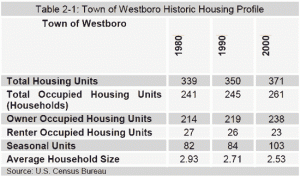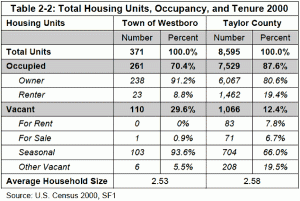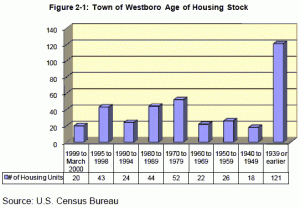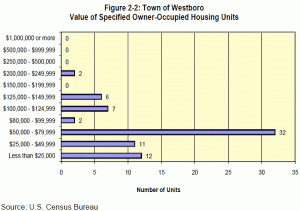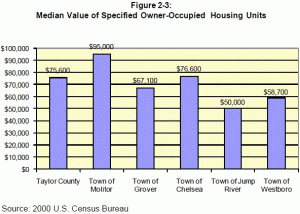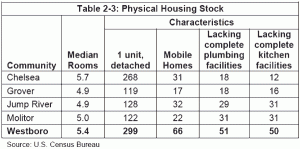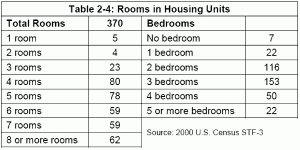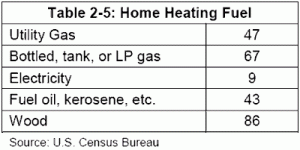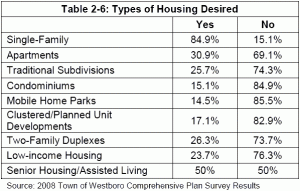Introduction
Housing is very important to the citizens of the Town of Westboro, representing in many cases the largest expenditure individuals will make. This element will look at different characteristics of the housing stock in the Town of Westboro,and in some cases neighboring towns and Taylor County, to help make sure that the needs of present and future residents are addressed in this plan.
Housing Inventory
Table 2-1 details historic housing information from 1980 to 2000. In that 20-year period, Westboro added 32 housing units, 62.5 percent of which were occupied. The gradual decline in average household size is a trend common throughout northern and rural Wisconsin. The central trends causing this decline include the out-migration of inhabitants over the age of 18 for work or school, overall smaller family sizes, fewer families with children moving into the town, fewer children being born to Town of Westboro residents, and a steady divorce rate. Additionally, many households are composed of retired couples or are single person households.
Table 2-2 compares housing occupancy and tenure for Town of Westboro and Taylor County. Percentage wise, Westboro has a much lower occupancy rate than the County. There is a large difference between percentages of owner and renter-occupied housing units in the Town of Westboro and Taylor County. Westboro has a higher percentage of owner-occupied units than Taylor County, while the County has a higher percentage of renter-occupied units than Westboro. There is also a very large difference in the types of vacant units between the Town and the County. Almost 94 percent of vacant units in the Town are seasonal, compared to the County’s 66 percent. Average household size in Westboro is comparable to that of Taylor County.
Housing Age
Figure 2-1 shows housing age for the community. In the Town of Westboro, data shows that nearly 33% of the local housing stock was built before 1939. Recent housing growth from the 1990’s makes up over 23 percent of the total housing stock.
Housing Value
Figures 2-2 and 2-3 display home value statistics. Figure 2-2 breaks down the value of specified owner-occupied units in the Town of Westboro. According to the 2000 U.S. Census, most homes (32) are valued between $50,000 and $79,999. Figure 2-3 shows that the median housing value for specified owner occupied units in the Town of Westboro is higher than the median value for the Town of Jump River, but lower than the median values for other surrounding towns and Taylor County.
Physical Housing Stock Characteristics
The following tables (Table 2-2 through 2-4 looks at several select factors that measure the makeup of housing in the Town of Westboro. Table 2-2 compares some physical housing stock characteristics of Westboro to its surrounding towns. Most housing units in Westboro are 1-unit detached, meaning the structure is detached from any other house; that is, with open space on all four sides. Homes that lack complete kitchen and plumbing facilities in the Town are more than likely seasonal housing units used for occasional use.
Table 2-3 details the number of rooms in housing units in the Town of Westboro. Most homes in the town average between five and six total rooms and most have three bedrooms.
Wood is the most common home heating fuel used in the Town of Westboro, as shown in Table 2-4. It is followed by bottled,tank, or LP gas.
Survey Results on Housing
Town of Westboro residents overwhelmingly desire single family housing developments, as nearly 85 percent of surveyed residents favored them.
Housing Assistance Policies and Programs
Housing assistance programs are available through a number of different local, state, federal and regional organizations. This listing of programs may help the Town of Westboro to:
- Promote development of housing for residents of the Town of Westboro.
- Provide a range of housing choices that meet the needs of persons of all income levels and of all age groups and persons with special needs.
- Promote the availability of land for the development or redevelopment of low and moderate-income housing.
- Maintain or rehabilitate the Town’s existing housing stock.
Taylor County Housing Authority offers assistance for the following program areas.
Housing Cost Reduction Initiative (HCRI)
HCRI assistance is intended for lower income households. Eligible program expenditures include interest-free loans for past due rent, past due utility bills, first month’s rent, security deposits and utility deposits. Other program offerings may include assistance to homeowners with past due mortgage payments, property taxes, utilities and homeowner’s insurance, and homebuyers’ assistance in the form of down payments and closing costs. Additionally, short-term renters assistance may be available for rent and security / utility deposits and past due utilities. Availability of funding is based on the level of available funds.
Section 8 Long-Term Rental Subsidy Program
This long-term rental subsidy program is available to low income Taylor County families. To be eligible, you must have dependents, be 62 years or older, or disabled receiving SSI. Certain income limits apply. Based on monthly income, we may assist in part or in whole, with monthly rental payments on a long-term basis. Applicants must sign a one-year lease with the landlord, be current on utility bills and maintain the residence in a clean, safe and sanitary condition.
Community Development Block Grant (CDBG)
CDBG funds are available on a limited basis for home repairs to income-eligible homeowners. We will provide help with siding, wiring, heating, roofing, plumbing, insulation, grab bars, foundation repairs, well / septic systems, accessibility modifications and replacing doors and windows. Emergency funds are available for well / septic replacement, lead-based paint / asbestos abatement and hazardous wiring, heating or roofing.
HCRI Home Program
Taylor County Housing Authority has funds available to income-eligible households for purchasing a home. This must be a first-home purchase, and the home must be located in Taylor County. We can assist with a 0 percent interest, deferred payment home loan for 10 percent of a down payment and / or 100 percent of closing costs. The loan becomes payable in full when the home purchased is no longer the primary residence.
If you can't find what you are looking for on this website, please provide feedback.

